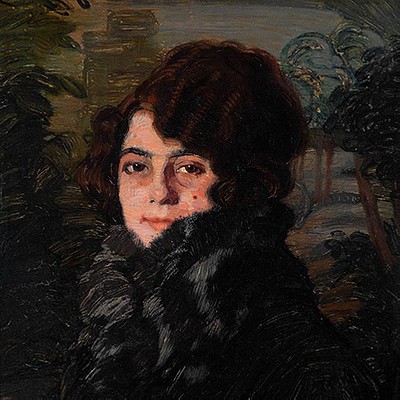JAVIER GOSÉ ROVIRA (Alcalá de Henares, 1876 - Lleida, 1915). "In the Paseo de Gracia". Mixed media on paper.
Lot 96
About Seller
Setdart Auction House
Carrer Aragó 346
Barcelona
Spain
Setdart Subastas was born in 2004 and is currently the first online art auction in Spain with solidity, prestige and reliability guaranteed by our more than 60,000 users. Setdart has a young, dynamic and enterprising team ready to successfully manage the purchase and sale of art works through custom...Read more
Categories
Estimate:
EUR€8,000 - EUR€10,000
$8,602.15 - $10,752.69
Absentee vs Live bid
Two ways to bid:
- Leave a max absentee bid and the platform will bid on your behalf up to your maximum bid during the live auction.
- Bid live during the auction and your bids will be submitted real-time to the auctioneer.
Bid Increments
| Price | Bid Increment |
|---|---|
| EUR€0 | EUR€10 |
| EUR€200 | EUR€25 |
| EUR€500 | EUR€50 |
| EUR€1,000 | EUR€100 |
| EUR€3,000 | EUR€200 |
| EUR€5,000 | EUR€500 |
| EUR€10,000 | EUR€1,000 |
| EUR€20,000 | EUR€2,000 |
| EUR€50,000 | EUR€5,000 |
About Auction
By Setdart Auction House
Jul 15, 2021
Set Reminder
2021-07-15 08:00:00
2021-07-15 08:00:00
America/New_York
Bidsquare
Bidsquare : 19th & 20th CENTURY PAINTINGS & ORIENTALISM
https://www.bidsquare.com/auctions/setdart-auction-house/19th-20th-century-paintings-orientalism-7212
Setdart Auction House sofia@setdart.com
Setdart Auction House sofia@setdart.com
- Lot Description
JAVIER GOSÉ ROVIRA (Alcalá de Henares, 1876 - Lleida, 1915). "In the Paseo de Gracia". Mixed media on paper. Signed in the lower right corner. Published in La Esquella de la Torratxa, num 1282, Barcelona July 31, 1903. Size: 30 x 40 cm; 59 x 69 cm (frame). Javier Gosé's style oscillates between modernism and French art-deco, reflecting the life of Parisian society, but also that of Barcelona. Inspired by the worldly life of the cafés-concert, prostitutes, horse races, sportsmen and the well-known Montmartre, his style reflects the finesse and delicacy of the French society of the time, although it is not exempt from a certain picaresque characteristic of carefree Paris. Francisco Javier Gosé was an essential draftsman and painter in the graphic world and fashion in the transition from the nineteenth to the twentieth centuries. He studied in Barcelona, where he was assistant to the draftsman José Luis Pellicer. He collaborated from a very early age in Barcelona publications, from ""La Esquella de la Torratxa"", ""La saeta"", in which his attachment to modernism is evident, to ""Mundial Magazine"" and ""Fémina"", where a pre-cubist line is already beginning to be seen. His first exhibition was held at Els Quatre Gats. During his time in Barcelona he portrayed the proletariat, although in 1900 he traveled to Paris, where he collaborated with ""La vie Illustrée"", ""Le frou-frou"", among others. He exhibited in the Barcelona galleries Parés and Dalmau, the Vilches gallery (Madrid), Georges Petit and Ritlinger (both in Paris). Until this moment his works showed a satirical and realistic look on the bourgeois, snobs and prostitutes, although this look changed in 1907, when he began a more stylized, less realistic and less ironic stage, especially for his start in the world of fashion, in which Gosé sought to set a trend among the female society. His time in Paris was the turning point in his life and artistic production, since the French capital was the place where he expanded his knowledge, becoming a successful artist who would get interesting commissions as illustrators in the best satirical magazines. In 1910 he began to collaborate with German magazines such as ""Ulk"". In 1914 the First World War broke out, a circumstance that, together with the serious health problems he was suffering, deprived him of the elegant Parisian environment, moving to the city of Vichy, famous for its spas. Soon after, Gosé moved back to Barcelona, spending the last days of his life in Lleida. Among the posthumous exhibitions, the Círculo Artístico, the same year of his death, the retrospective at the Rovira Gallery (1970) and the La Caixa Foundation (1984) stand out. He is represented in the Museums of Modern Art in Barcelona and Madrid, among others."
Dimension
Height: 30.00 cmWidth: 40.00 cm - Shipping Info
-
In-house shipping available. Please inquire at admin@setdart.com.
-
- Buyer's Premium



 EUR
EUR CAD
CAD AUD
AUD GBP
GBP MXN
MXN HKD
HKD CNY
CNY MYR
MYR SEK
SEK SGD
SGD CHF
CHF THB
THB

















